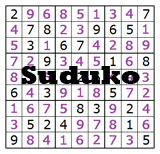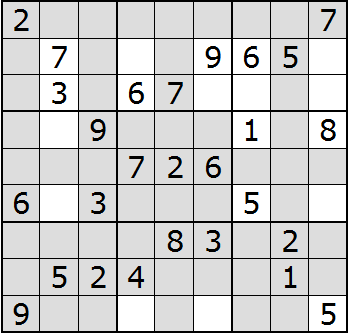 |
 |
 |
 |
Triangulation uses a single number and its positions in the puzzle to find other spaces in which that number belongs. Two instances of the number may determine the position of a third instance, hence: triangulation. However, triangulation works with with as few as one number or as many as four or five but triangulation seems like a good name so I'll stick with it.
Triangulation works by imaging that the rows or columns with a number are shaded. Here is our puzzle with rows and columns containing 2 shaded:

Because each block may only contain a single 2, we'll shade all the spaces in each block with a 2:

Each unshaded space without a number is a potential location for the number 2. Remember the goal, numbers 1 to 9 in each block, row, and column. Looking at the blocks from left to right, top to bottom, the second, fourth, and eighth blocks have two empty spaces. Block three has three empty spaces. There is a single unshaded space in block six. We can put a 2 there.

If you can imagine all that shading, go for it. But if you're like me, you can't so work with a single row or column of blocks. In the first column of blocks, the second and third columns contain 3. That leaves two unshaded spaces in the bottom block:

But there is also a 3 in block eight. If that row is shaded, there is a single, unshaded space in block seven. A 3 belongs there—Triangulation: the position of three 3s determines the location of a fourth 3:

I'm only going to shade rows or columns, not the blocks, in the examples that follow just as I did in the example above.
Going through the puzzle one number at a time, we find:
We are able to fill in eight spaces. If we do it all over again, we can fill seven more spaces: |
||
The puzzle so far:
|
||
You may be able to solve easy suduko puzzles with just triangulation. In more difficult puzzles, after two rounds of triangulation, I use the elimination tool. As we're able to fill spaces with the elimination tool, we'll return to triangulation. |
After two rounds of triangulation:
|
